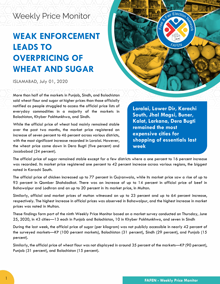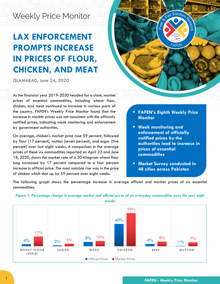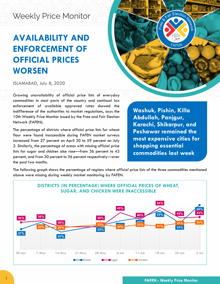ISLAMABAD, July 01, 2020: More than half of the markets in Punjab, Sindh, and Balochistan sold wheat flour and sugar at higher prices than those officially notified as people struggled to access the official price lists of everyday commodities in a majority of the markets in Balochistan, Khyber Pakhtunkhwa, and Sindh.
While the official price of wheat had mainly remained stable over the past two months, the market price registered an increase of seven percent to 46 percent across various districts, with the most significant increase recorded in Loralai. However, the wheat price came down in Dera Bugti (five percent) and Jacobabad (24 percent).
The official price of sugar remained stable except for a few districts where a one percent to 16 percent increase was recorded. Its market price registered one percent to 42 percent increase across various regions, the biggest noted in Karachi South.
The official price of chicken increased up to 77 percent in Gujranwala, while its market price saw a rise of up to 93 percent in Qamber Shahdadkot. There was an increase of up to 14 percent in official price of beef in Bahawalpur and Lodhran and an up to 20 percent in its market price, in Multan.
Similarly, official and market prices of mutton witnessed an up to 23 percent and up to 64 percent increase, respectively. The highest increase in official prices was observed in Bahawalpur, and the highest increase in market prices was noted in Multan.
These findings form part of the ninth Weekly Price Monitor based on a market survey conducted on Thursday, June 25, 2020, in 43 cities—13 each in Punjab and Balochistan, 10 in Khyber Pakhtunkhwa, and seven in Sindh
During the last week, the official price of sugar (per kilogram) was not publicly accessible in nearly 42 percent of the surveyed markets—KP (100 percent markets), Balochistan (31 percent), Sindh (29 percent), and Punjab (15 percent).
Similarly, the official price of wheat flour was not displayed in around 35 percent of the markets—KP (90 percent), Punjab (31 percent), and Balochistan (15 percent).
The official prices of four pulses—moong, masoor, mash, and channa—were inaccessible in seven percent to 20 percent of the surveyed markets. At the same time, the prices of milk and yogurt were not publicly obtainable in 23 percent and 30 percent districts, respectively.
Moreover, mutton and beef prices were missing in 19 percent and 16 percent of the districts. The official price lists of regular vegetables—potatoes, onions, and tomatoes—were found inaccessible in 12 percent to 14 percent of the observed markets, mostly in Balochistan and Sindh.

Weak enforcement of official prices inconvenienced ordinary citizens as traders sold several commodities at higher rates than the officially notified prices. Daal moong and masoor were overpriced in 53 percent of the surveyed districts, mash in 49 percent areas, and channa in 51 percent regions. The pulses went Rs124 to Rs193 above the official price. Like the last two weeks, Karachi South remained the most expensive city to shop for pulses.
Among the everyday vegetables, potatoes and onions were overpriced in 37 percent and 40 percent districts, respectively, while tomatoes were overpriced in 30 percent of the regions. The price of tomatoes went Rs60 higher than the notified rate in Dera Bugti, while potatoes and onions were sold Rs30 above the announced prices in Kalat and Larkana.
In the meat category, beef and mutton (average quality with bone) were overpriced in 53 percent and 56 percent districts, and chicken in 26 percent areas. Mutton, beef, and chicken were priced at Rs930, Rs450, and Rs100, respectively, above the official rates. Karachi South remained the most expensive market for mutton and beef, and Buner for chicken on Thursday.
Traders sold wheat flour and refined sugar above the official rates in 49 percent and 40 percent districts. A 20-kilogram bag of wheat flour was priced Rs400 above the official rate in Loralai, and refined sugar Rs21 more than the market price in Karachi South.
The market rates of eggs per dozen were above the officially notified prices in 21 percent districts. At the same time, the prices of milk and yogurt were higher than the official rates in 35 percent and 30 percent of the surveyed areas.
TDEA-FAFEN generates the Weekly Price Monitor covering 15 essential kitchen items, including groceries such as wheat, pulses, oil, sugar, and perishable commodities like meat, and vegetables. It does this considering the need for an independent and regular assessment of the availability of such items.
The observers obtain the official prices from the officials of district administrations, or market committees, and collect the wholesale prices through market surveys. In Punjab’s case, the government price app ’Qeemat Punjab’ is also used to get the official rates.
To download this report, click here




